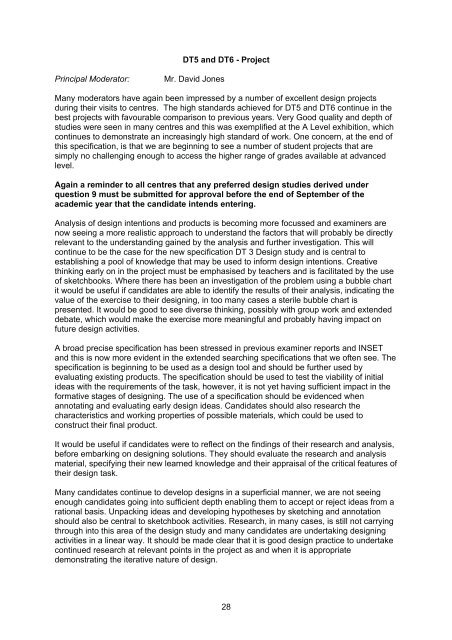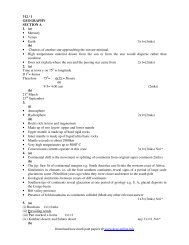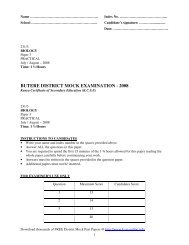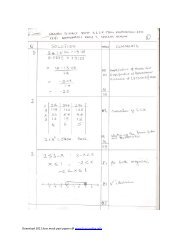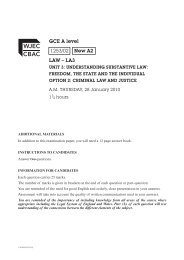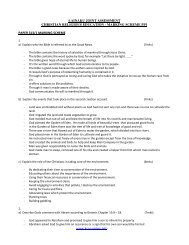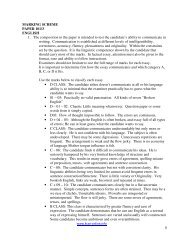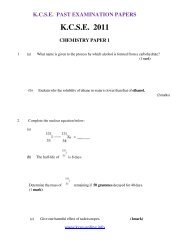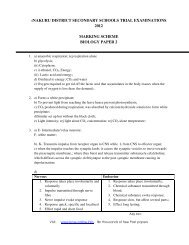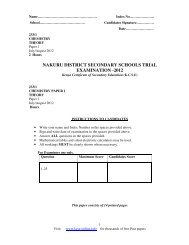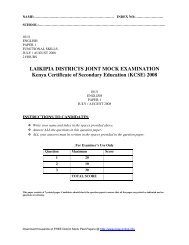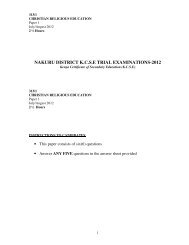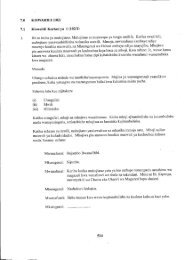GCE D&T Legacy Examiners Report 2009 - kcse past papers | 2013 ...
GCE D&T Legacy Examiners Report 2009 - kcse past papers | 2013 ...
GCE D&T Legacy Examiners Report 2009 - kcse past papers | 2013 ...
You also want an ePaper? Increase the reach of your titles
YUMPU automatically turns print PDFs into web optimized ePapers that Google loves.
DT5 and DT6 - Project<br />
Principal Moderator:<br />
Mr. David Jones<br />
Many moderators have again been impressed by a number of excellent design projects<br />
during their visits to centres. The high standards achieved for DT5 and DT6 continue in the<br />
best projects with favourable comparison to previous years. Very Good quality and depth of<br />
studies were seen in many centres and this was exemplified at the A Level exhibition, which<br />
continues to demonstrate an increasingly high standard of work. One concern, at the end of<br />
this specification, is that we are beginning to see a number of student projects that are<br />
simply no challenging enough to access the higher range of grades available at advanced<br />
level.<br />
Again a reminder to all centres that any preferred design studies derived under<br />
question 9 must be submitted for approval before the end of September of the<br />
academic year that the candidate intends entering.<br />
Analysis of design intentions and products is becoming more focussed and examiners are<br />
now seeing a more realistic approach to understand the factors that will probably be directly<br />
relevant to the understanding gained by the analysis and further investigation. This will<br />
continue to be the case for the new specification DT 3 Design study and is central to<br />
establishing a pool of knowledge that may be used to inform design intentions. Creative<br />
thinking early on in the project must be emphasised by teachers and is facilitated by the use<br />
of sketchbooks. Where there has been an investigation of the problem using a bubble chart<br />
it would be useful if candidates are able to identify the results of their analysis, indicating the<br />
value of the exercise to their designing, in too many cases a sterile bubble chart is<br />
presented. It would be good to see diverse thinking, possibly with group work and extended<br />
debate, which would make the exercise more meaningful and probably having impact on<br />
future design activities.<br />
A broad precise specification has been stressed in previous examiner reports and INSET<br />
and this is now more evident in the extended searching specifications that we often see. The<br />
specification is beginning to be used as a design tool and should be further used by<br />
evaluating existing products. The specification should be used to test the viability of initial<br />
ideas with the requirements of the task, however, it is not yet having sufficient impact in the<br />
formative stages of designing. The use of a specification should be evidenced when<br />
annotating and evaluating early design ideas. Candidates should also research the<br />
characteristics and working properties of possible materials, which could be used to<br />
construct their final product.<br />
It would be useful if candidates were to reflect on the findings of their research and analysis,<br />
before embarking on designing solutions. They should evaluate the research and analysis<br />
material, specifying their new learned knowledge and their appraisal of the critical features of<br />
their design task.<br />
Many candidates continue to develop designs in a superficial manner, we are not seeing<br />
enough candidates going into sufficient depth enabling them to accept or reject ideas from a<br />
rational basis. Unpacking ideas and developing hypotheses by sketching and annotation<br />
should also be central to sketchbook activities. Research, in many cases, is still not carrying<br />
through into this area of the design study and many candidates are undertaking designing<br />
activities in a linear way. It should be made clear that it is good design practice to undertake<br />
continued research at relevant points in the project as and when it is appropriate<br />
demonstrating the iterative nature of design.<br />
28


